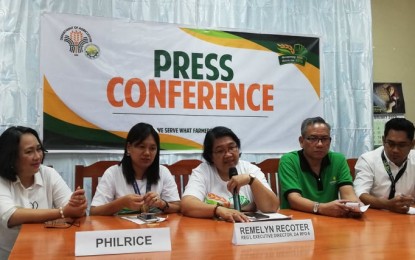
REAPING BENEFITS. The Department of Agriculture in Western Visayas (DA 6) said on Thursday (Mar. 5, 2020) rice consumers benefited from the Rice Tariffication Law because of the variety of rice choices. Remelyn Recoter (middle), regional executive director of DA 6, says the farmers will reap the direct benefits of the law this year. (PNA photo by Gail Momblan)
ILOILO CITY – After a year of the implementation of the Rice Tariffication Law (RTL) on Thursday, the Department of Agriculture in Western Visayas (DA-6) said farmers in the region will further gain from its benefits this year.
Remelyn Recoter, regional executive director of DA 6, said in a press conference the first year of the RTL implementation has done good to the consumers.
Citing studies, Recoter said the RTL has caused a 10 percent rice price drop.
“We are requesting our farmers to give chance to our law because there had been clamors to amend the law. We are hoping this 2020, the 2019 (budget) and the 2020 will be implemented,” she said.
As of Thursday, the DA 6 has received 2,578 letters of intent from farmer cooperatives and associations.
Recoter said more than half of the number has already been accredited and can avail of the benefits under the RTL.
The Philippine Rice Research Institute (PhilRice), one of the implementing agencies of the RTL, has already kicked off its distribution of seeds.
Fennie Lyn Pantin, regional focal person of PhilRice, however, said the distribution of seeds to farmer cooperatives and associations was done in the third week of October last year. “Some of the farmers have already planted when the seeds arrived,” she said.
Recoter said the certified seeds that will be distributed to the farmers will increase one metric ton of harvest per hectare.
On the other hand, the Philippine Center for Postharvest Development and Mechanization (PhilMech), another implementing agency, will start distributing farm machinery this March.
Thirty-eight farmers’ cooperatives and associations will benefit from the mechanization, which include farm equipment like four-wheel tractor, hand tractor, floating tiller, combine harvester, among others.
“For the mechanization, the intention is to decrease the cost of production because the biggest expense in rice farming is labor that is about more or less 30 to 40 percent,” Recoter said.
For the first year of the RTL implementation, the Landbank of the Philippines has also assisted farmers in rice production.
Giovanni Baoy, Land Bank of the Philippines Capiz Lending Center head, said that the bank has so far released PHP17.6 million to 194 farmers for palay production.
“The budget is PHP42, 000 per hectare for hybrid and PHP37, 000 per hectare of inbred,” Baoy said. (PNA)
